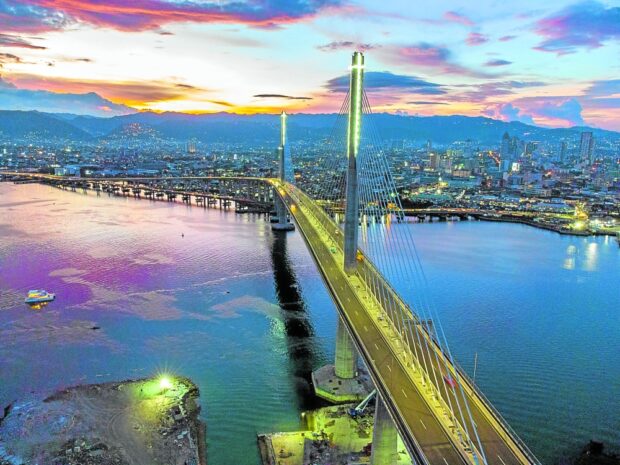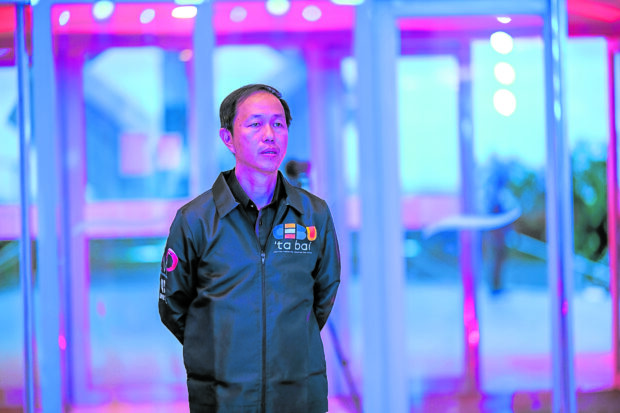CEBU CITY—About a week before Christmas Day in 2021, a strong typhoon crippled this premier city in Central Visayas: Power and communication lines were down. Water supply was cut off. Homes and establishments were either damaged or destroyed.
But three months later, Cebu, particularly Cebu City, was back on its feet, as if the tragedy did not happen. And this was all due to the strong partnership between the city government and the private sector.

The CCLEX bridge and the South Road Properties are symbols of resurgence. —PHOTOS BY EMMANUELLE SAWIT
This is the kind of collaboration that the city government is banking on to realize its vision for a Singapore-like Cebu City.
According to Mayor Michael Rama, the private sector plays a big role in achieving the people’s “collective aspiration” under his “people privately-driven governance.”
“What we have in the City of Cebu is the people, the convergence—multisectoral, all walks of life, no political color. We all have to sit down through a convergence [in achieving the goal],” he said.

Charles Kenneth Co, president of Cebu Chamber of Commerce
Charles Kenneth Co, president of the Cebu Chamber of Commerce and Industry, said the vision was not to turn Cebu City exactly like Singapore.
‘Paradigm shift’ Rather, he said, it is a “paradigm shift” of having to modernize the city—make it cleaner, more attractive to investors and tourists and improve the economy—to make the lives of Cebuanos better.
One of the steps taken by the city was to clear the waterways to address the flooding problem.
The city also tapped big conglomerates to build medium-rise buildings (MRBs) to house people whose homes would be demolished for encroaching the 3-meter easement.
In a presentation during Rama’s “People’s State of the City Address” on July 3, eight developers promised to build these MRBs for displaced residents.
The mayor has also embarked on a series of investment marketing activities that received pledges from several companies that would start new ventures in the city. Among these are transportation services that will complement the Bus Rapid Transit (BRT), the country’s first bus-based transit system.
The French government taps renowned artists Ceet Fouad and Distort Monsters to make the Ayala Flyover on Archbishop Reyes Avenue pop
A business tycoon had signified his plan to build a dam in Cebu’s highlands.
The city has entered into a joint venture with Megawide Corp. for the modernization of the Carbon Market, Cebu’s biggest and oldest public market. According to Co, another plan was to develop the Waterfront area, which had long been neglected, and set up a board that would carry out the long-term plans.
BPO, tourism
At present, tourism and the operation of business process outsourcing (BPO) companies are the main boosters of Cebu City’s economy.
There are 320 BPO operators in Cebu City directly employing 220,000 people, according to Buddy Villasis, executive director of Cebu IT-BPM (Information Technology/Business Process Management) Organization, the leading industry board representing the IT-BPM sector in Cebu and Central Visayas.
The number does not include the about 600,000 in indirect employment from industries that benefit the presence of the BPOs, such as restaurants and bars.
The number of employees is expected to increase by 50,000 in the next five years as the BPO industry continues to grow, Villasis said.
BPO companies, he said, want to put up their businesses in Cebu City because of a better work-life balance. “Things are more flexible here. You can still enjoy a few hours at the beach or the mountains before going to work,” he says.
Villasis also said they also work closely with Cebu City to address the need of and further strengthen the industry.
The BPO industry was hardly affected by community lockdowns imposed during the height of the COVID-19 pandemic from 2020 to 2022. It has instead triggered a hybrid setup where employees now have the option to work at home.
But such cannot be said about tourism.
According to Co, tourism arrivals have yet to reach prepandemic levels.
“I think tourism is still maybe 50 to 70 percent back,” he said, adding that it is the domestic tourists who carry the bulk of the arrivals and not foreigners.
To address this, Co said they were looking at ways to make it easier for foreigners to get a Philippine visa.
“I think we’ve already made strides with China. For the group tours, instead of having to individually apply for their visa, they can apply as a group,” he said.
Another initiative is to make the visa application online.
The Cebu IT park near Apas and Lahug is the heart of Cebu’s thriving corporate and business scene—PHOTOS BY EMMANUELLE SAWIT
Challenge
But continuity is one challenge that Cebu City must overcome in order to achieve its Singapore-like vision.
Co pointed out that projects and programs that have been put in place must be continued by whoever will lead City Hall.
“(The vision) is about modernization and having a sustainable environment,” he said.
One aspect that needs to be modernized is transportation.
Although civil works for BRT are already ongoing and the jeepney modernization has been put in place, these can still hardly address the needs of local commuters.
“We are hoping we can get something like mass transit, whether it’s LRT (light rail transit) or subway. Manila is already starting it. Hopefully, it will trickle down,” Co said.
Mayor Michael Rama says private sector will play key role in achieving goals for Cebu City.
Rama has already initiated the conduct of studies for a possible rollout of monorail along coastlines, LRT through the hinterlands traversing north to south, cable car system to the highlands, and a subway system, among others.
In line with its Singapore-like vision, the city government has also been bent on beautifying the city: sidewalks have been redesigned to make it more accessible, side-streets are being landscaped, old parks are being improved while new parks are being opened.
Asked what would be the chamber’s vision for Cebu City, Co replied: “We’d like Cebu City to be an investment gateway.”
Playing Catch up
He pointed out that the Philippines, Cebu City in particular, has been behind in foreign direct investments (FDIs).
“We haven’t been promoting the Philippines as an investment destination. We are way behind other countries,” he said.
Singapore, Co said, is highly developed because all multinationals have their headquarters there.
“Hopefully we can get a small piece of that. It would be a big help for us,” he added.
Aside from private sector support, what makes the goal achievable is the unity among officials – from the national level down to the barangay –as indicated by the absence of political bickering.
As Rama has pointed out: “Progress can only be attained when we are one in making it happen.” WITH REPORTS FROM NESTLE SEMILLA INQ

